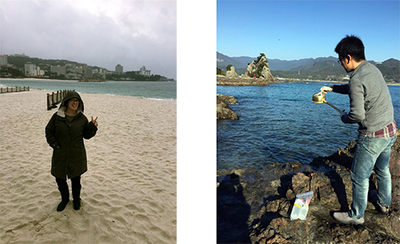ELSI Blog
138 "Roughing it" in Wakayama: My first time in the field
As an experimental molecular and microbiologist by training, I have spent my entire scientific career safely ensconced in climate-controlled buildings: working at the lab bench, typing behind my computer screen, or maybe copying articles in the library (I'm old enough to remember when we still had to do this). The closest I ever came to working in unique environmental conditions was having to purify proteins in the cold room (4°C), or run a kinetic analysis in the warm room (37°C), sometimes running from one to the other during quick breaks to warm up (or cool down). So I was thrilled during my first month at ELSI when Research Scientist Tomohiro Mochizuki invited me to assist him with field collections in Wakayama prefecture.
Wakayama-ken is located at the tip of the Kii peninsula in the Kansai region. The Kii peninsula is covered with temperate rainforest, and the rocky coast hosts the most pole ward coral reefs in the world, thanks to a warm ocean current nearby. In addition to being happy to get out of chilly Tokyo in February, I was really curious to see this part of Japan for the first time, and I was super-excited for my first time actually carrying out fieldwork. Our flight was almost canceled due to bad weather, but after a short 1 hour trip from Haneda airport, we landed in a very rainy Shirahama (a popular beach town in the summer) and began our hunt for samples.
We were interested in collecting water samples to discover new types of phage. Phage are a type of harmless virus. They can't infect human or even animal cells, and instead only infect simple single-celled microorganisms. We wanted to look for extremophile phage - phage that live in extreme conditions like very hot temperatures or high salinity - to better understand how life deals with these types of environments, which may have been common on the early earth. Because of its abundance of geothermal activity, Japan is the perfect place to study extremophile phage - we just had to find the right hot spring! Fortunately for me, (but perhaps to the envy of my ecologist colleagues at UCSD, who conduct their fieldwork wading through muddy marshes or wearing bee-proof mesh bodysuits), nearly every hot spring in Japan has become a fully developed onsen. So our fieldwork didn't involve much dangerous trekking or getting dirty, but rather a lot of polite requests for access to unfiltered source water in charming seaside and mountain towns, followed by a nice soak in the local onsen after the day's work was complete.
 Armed with record sheets, sample containers, instruments, umbrellas, raincoats, (somewhat) water-proof shoes, and a long-handled sampling ladle, we gathered samples in Shirahama, on the west coast of the peninsula. One sample was from the onsen-tamago shop, where the spring water is hot enough to soft-boil an egg (and has been used for that purpose for many decades). After Shirahama, we turned inland and carefully drove up into the mountains to Yunomine Onsen. Due to the heavy rains, the stream that cuts through the center of the tiny village had flooded, so we couldn't sample from Yunomine's famous tamago-cooking pit next to the stream, but we could get samples from the public baths. As dusk fell and the town's lanterns came on, the freshly washed Yunomine glowed through the steam and twilight in the finally slowing rain.
Armed with record sheets, sample containers, instruments, umbrellas, raincoats, (somewhat) water-proof shoes, and a long-handled sampling ladle, we gathered samples in Shirahama, on the west coast of the peninsula. One sample was from the onsen-tamago shop, where the spring water is hot enough to soft-boil an egg (and has been used for that purpose for many decades). After Shirahama, we turned inland and carefully drove up into the mountains to Yunomine Onsen. Due to the heavy rains, the stream that cuts through the center of the tiny village had flooded, so we couldn't sample from Yunomine's famous tamago-cooking pit next to the stream, but we could get samples from the public baths. As dusk fell and the town's lanterns came on, the freshly washed Yunomine glowed through the steam and twilight in the finally slowing rain.
We finished crossing through the mountains, and the next day, on the east side of the peninsula, we scrambled over rocky tide pools to collect seawater from a place where runoff from multiple springs gathers in the ocean. We returned to Shirahama by following the coastal road around the bottom of the peninsula, then took a train north to Arima Onsen, outside of Kobe, for a final day of sampling. We completed our trip by visiting Tousen Jinja, the shrine dedicated to hot springs, and filling out wooden ema with our wishes for good research results. Before leaving Arima, I got to sample Kansai-style takoyaki (octopus fritters), which are served with a clear, delicate broth for dipping in place of the sweet brown sauce, mayonnaise, and bonito you see on top of them in Tokyo. The Kansai-style takoyaki were one of the best foods I have ever eaten in Japan or anywhere!
I don't think I could have asked for a better, or more uniquely Japanese, first fieldwork experience, and I can't wait until I return to ELSI later this year and hopefully go on another "expedition."













